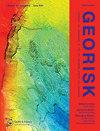Report for ISSMGE TC309/TC304/TC222 Third ML dialogue on “Data-Driven Site Characterization (DDSC)”
IF 4.8
3区 工程技术
Q1 ENGINEERING, GEOLOGICAL
Georisk-Assessment and Management of Risk for Engineered Systems and Geohazards
Pub Date : 2022-08-01
DOI:10.1080/17499518.2022.2105366
引用次数: 7
Abstract
ABSTRACT The ISSMGE TC309/TC304/TC222 Third Machine Learning in Geotechnics Dialogue (3MLIGD) was hosted online by the Norwegian Geotechnical Institute on 3 December 2021. There is a consensus that the potential of digital transformation in geotechnical site characterisation is significant. Nonetheless, there is a clear-eyed recognition that the industry is currently governed by a set of rules that evolved from Industry 3.0 and it is only beginning to explore the potential of digital technologies. This state is to be expected as digital transformation is expected to change the “rules of the game” in the context of Industry 4.0 that is rapidly evolving in tandem with emerging technologies. The number of practitioners and researchers who are interested in data-centric geotechnics remains a small minority. There is a unanimous view that this small community can achieve greater impact and hasten progress by fostering more collaborations and working more closely together through: (1) data sharing, (2) creating a “yellow page” of people and projects to facilitate greater connectivity, (3) establishing novel collaborative modes between industry and academia, (4) demonstrating value through “ML supremacy” projects that include mapping studies covering large, real-time, multi-source datasets over large spatial domains, and (5) educating young talents by creating ML internships.ISSMGE TC309/TC304/TC222第三次ML对话“数据驱动的站点特征(DDSC)”报告
摘要ISSMGE TC309/TC304/TC222岩土工程第三次机器学习对话(3MLIGD)于2021年12月3日由挪威岩土工程研究所在线主办。人们一致认为,数字化改造在岩土工程现场特征描述方面的潜力是巨大的。尽管如此,人们清醒地认识到,该行业目前受到一套从工业3.0演变而来的规则的管理,而且它才刚刚开始探索数字技术的潜力。在工业4.0的背景下,随着新兴技术的快速发展,数字化转型有望改变“游戏规则”,这种状态是意料之中的事。对以数据为中心的土工技术感兴趣的从业者和研究人员仍然是少数。一致认为,这个小社区可以通过以下方式促进更多的合作和更紧密的合作,从而产生更大的影响并加快进展:(1)数据共享,(2)创建人员和项目的“黄页”,以促进更大的连通性,(3)在工业界和学术界之间建立新的合作模式,(4)通过“ML至上”项目展示价值,包括在大空间域上覆盖大型实时多源数据集的映射研究,以及(5)通过创建ML实习来培养年轻人才。
本文章由计算机程序翻译,如有差异,请以英文原文为准。
求助全文
约1分钟内获得全文
求助全文
来源期刊
CiteScore
8.70
自引率
10.40%
发文量
31
期刊介绍:
Georisk covers many diversified but interlinked areas of active research and practice, such as geohazards (earthquakes, landslides, avalanches, rockfalls, tsunamis, etc.), safety of engineered systems (dams, buildings, offshore structures, lifelines, etc.), environmental risk, seismic risk, reliability-based design and code calibration, geostatistics, decision analyses, structural reliability, maintenance and life cycle performance, risk and vulnerability, hazard mapping, loss assessment (economic, social, environmental, etc.), GIS databases, remote sensing, and many other related disciplines. The underlying theme is that uncertainties associated with geomaterials (soils, rocks), geologic processes, and possible subsequent treatments, are usually large and complex and these uncertainties play an indispensable role in the risk assessment and management of engineered and natural systems. Significant theoretical and practical challenges remain on quantifying these uncertainties and developing defensible risk management methodologies that are acceptable to decision makers and stakeholders. Many opportunities to leverage on the rapid advancement in Bayesian analysis, machine learning, artificial intelligence, and other data-driven methods also exist, which can greatly enhance our decision-making abilities. The basic goal of this international peer-reviewed journal is to provide a multi-disciplinary scientific forum for cross fertilization of ideas between interested parties working on various aspects of georisk to advance the state-of-the-art and the state-of-the-practice.

 求助内容:
求助内容: 应助结果提醒方式:
应助结果提醒方式:


